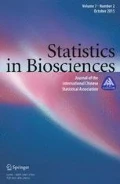Abstract
Omics-based technology platforms have made new kinds of cancer profiling tests feasible. There are several valuable examples in clinical practice, and many more under development. A concerted, transparent process of discovery with lock-down of candidate assays and classifiers and clear specification of intended clinical use is essential. The Institute of Medicine has now proposed a three-stage scheme of confirming and validating analytical findings, validating performance on clinical specimens, and demonstrating explicit clinical utility for an approvable test (Micheel et al., Evolution of translational omics: lessons learned and path forward, 2012).


Similar content being viewed by others
References
Collins FS (2010) Research agenda: opportunities for research and NIH. Science 327:36–37
Farrah T, Deutsch EW, Omenn GS, Campbell DS, Sun Z, Bletz JA, Mallick P, Katz JE, Malmström J, Ossola R, Watts JD, Lin B, Zhang H, Moritz RL, Aebersold R (2011) A high-confidence human plasma proteome reference set with estimated concentrations in PeptideAtlas. Mol Cell Proteomics 10:9. doi:10.1074/mcp.M110.006353
Lander ES, Linton LM, Birren B et al (2001) Initial sequencing and analysis of the human genome. Nature 409:860–921
Menon R, Omenn GS (2010) Proteomic characterization of novel alternative splice variant proteins in human epidermal growth factor receptor 2/neu-induced breast cancers. Cancer Res 70:3440–3449
Menon R, Zhang Q, Zhang Y, Fermin D, Bardeesy N, DePinho RA, Lu C, Hanash SM, Omenn GS, States DJ (2009) Identification of novel alternative splice isoforms of circulating proteins in a mouse model of human pancreatic cancer. Cancer Res 69:300–309
Menon R, Roy A, Mukerjee S, Belkin S, Zhang Y, Omenn GS (2011) Functional implications of structural predictions for alternative splice proteins expressed in Her2/neu-induced breast cancers. J Proteome Res 10:5503–5511
Micheel C, Nass S, Omenn GS (eds) (2012) Evolution of translational omics: lessons learned and path forward. National Academy Press, Washington, DC
Omenn GS (2012) Gene-environment interactions: eco-genetics and toxicogenomics. In: Ginsburg G, Willard H (eds) Genomic and personalized medicine, 2nd edn. Elsevier, New York, pp 50–59
Omenn GS, Yocum AK, Menon R (2010) Alternative splice variants, a new class of protein cancer biomarker candidates: findings in pancreatic cancer and breast cancer with systems biology implications. Dis Mark 28:241–251
Ostroff RM, Bigbee WL, Franklin W et al (2010) Unlocking biomarker discovery: large scale application of aptamer proteomic technology for early detection of lung cancer. PLoS One 5:e15003. doi:10.1371/journal.pone.0015003
Shedden K, Taylor JM, Enkemann SA (2008) Gene expression-based survival prediction in lung adenocarcinoma: a multi-site, blinded validation study. Nat Med 14:822–827
Sreekumar A, Poisson LM, Rajendiran TM, Khan AP, Cao Q, Yu J, Laxman B, Mehra R, Lonigro RJ, Li Y, Nyati MK, Ahsan A, Kalyana-Sundaram S, Han B, Cao X, Byun J, Omenn GS, Ghosh D, Pennathur S, Alexander DC, Berger A, Shuster JR, Wei JT, Varambally S, Beecher C, Chinnaiyan AM (2009) Metabolomic profiles delineate potential role for sarcosine in prostate cancer progression. Nature 457:910–914
Tarcea VG, Weymouth T, Ade A et al (2009) Michigan Molecular Interactions r2: from interacting proteins to pathways. Nucl Acids Res 37:D642–646
Tomlins SA, Rhodes DR, Perner S et al (2005) Recurrent fusion of TMPRSS2 and ETS transcription factor genes in prostate cancer. Science 310:644–648
Van de Vijver MJ, He YD, van’t Veer LJ (2002) A gene-expression signature as a predictor of survival in breast cancer. NEJM 347:1999–2009
Venter JC, Adams MD, Myers EW et al (2001) The sequence of the human genome. Science 281:1304–1351
Wang XV, Verhaak RG, Purdom E, Spellman PT, Speed TP (2011) Unifying gene expression measures from multiple platforms using factor analysis. PLoS One 6:e17691
Zhang Z, Chan DW (2010) The road from discovery to clinical diagnostics: lessons learned from the first FDA-cleared in vitro diagnostic multivariate index assay of proteomic biomarkers. Cancer Epidemiol Biomark Prev 19:2995–2999
Author information
Authors and Affiliations
Corresponding author
Rights and permissions
About this article
Cite this article
Omenn, G.S. Strategies for Genomic and Proteomic Profiling of Cancers. Stat Biosci 8, 1–7 (2016). https://doi.org/10.1007/s12561-014-9111-7
Received:
Accepted:
Published:
Issue Date:
DOI: https://doi.org/10.1007/s12561-014-9111-7




